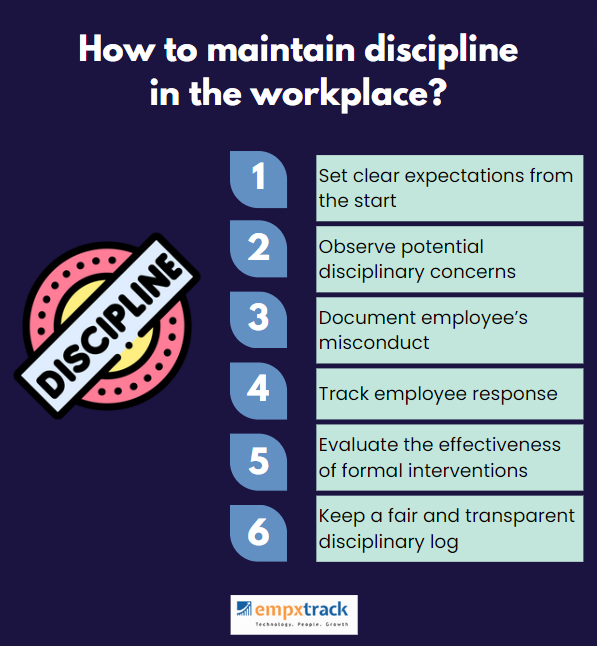This blog talks about the importance of employee discipline in an organization and discusses best HR practices to develop a disciplined workforce.
Discipline means a prescribed conduct or pattern of behavior. Employee discipline at the workplace can be defined as adherence to the company policies, rules, regulations and processes laid down by the management. In a disciplined work environment, employees have self-control, orderly conduct, and work dedicatedly.
As rightly said by Jim Rohn,
With discipline comes self-restraint and responsibility.
Productivity and performance at work can decline when employees lack discipline and engage in non-work-related activities. For example taking extended breaks, spending excessive time on social media can both negatively impact efficiency. Additionally, arriving late to the office, and engaging in lengthy water cooler conversations further undermine overall performance. They fall behind in achieving their targets and accomplishing the task at hand. As a result, they feel demotivated and there is a vicious spiral of productivity loss with overall drop in team performance.
Employee discipline enables a positive and healthy work environment and ensures smooth functioning of the organization. It is one of the primary responsibilities of HR to evolve relevant disciplinary policies and ensure their adherence.
Common issues related to Employee Discipline
Non disciplinary behavior by employees can disturb the decorum of the entire workplace. It can damage the reputation of the organization and adversely affect its profitability and growth.
There are multiple types of disciplinary issues that may take place in a workplace. Here are a few examples related to employee discipline.
Compliance issues
- » Providing wrong information or hiding factual personal data during recruitment
- » Non-compliance with the terms of employment contract, for example an employee takes up an additional job while still working in your organization.
- » Violation of company policies, rules & regulations
- » Non-adherence to workplace safety instructions
- » Indulgence in theft and fraud in the company
- » Absconding without resignation
- » False medical, travel and expense claims
Behavioral issues
- » Exhibiting misconduct towards manager, leadership and co-workers
- » Reporting late to work or team meetings
- » Frequent leave without intimation and approvals
- » Indulging in political activities and anti-social activities
- » Not completing work assignments on time or repeatedly not meeting goals
- » Refusal to attend training programs
- » Not marking attendance
- » Wasting time on social media and other web-sites that are not related to work
- » Bullying other colleagues
- » Sexual harassment
Guidelines for Managing Employee Discipline
Often, we associate discipline with punishment.
Well, that’s not the case.
An effective disciplinary policy ensures proper order at the workplace through corrective behavior. Discipline management is intended to promote a minimum acceptable behavior by employees. With organizational discipline, the employees learn to behave in a controlled and responsible way and start abiding by the guidelines laid down by the organization.
It is part of the human resource team’s responsibility to look into the employee disciplinary issues.

To develop a disciplined workforce in your organization, refer to the following guidelines and enforce corrective measures.
Policy Formulation
- It is essential to have a properly laid down and unambiguous company policy that defines the code of conduct expected from employees in various contexts (attendance, leave, employee interactions, customer interactions, sexual harassment, dress code, submission of expenses etc.).
- The policy should be regularly updated, reviewed and shared with all employees in an easily accessible employee handbook format.
- The consequences of violating the policy must be clearly articulated.
- We recommend that the policy document be shared in your employee portal and employees should be expected to read and accept the document during on-boarding and at least once each year.
Disciplinary Committee
- A disciplinary committee should be formed where employees can report issues pertaining to discipline.
- This committee should take care of discipline management and document all disciplinary actions taken against the defaulters.
- The objective of disciplinary actions should be a transformation in the employee behavior. The disciplinary action therefore should be Corrective, rather than destructive and should be carried out with rationality and without any bias.
- Follow the technique of Progressive Discipline. This type of disciplinary approach follows the progression of disciplinary actions. Start from verbal counselling to written warning to monetary deductions. And if needed, you can opt for suspension of the concerned employee. Termination of employee services should be a last resort.
- Process of Redressal of Complaints should be fair, confidential and transparent. Create an online Helpdesk to address employee complaints & grievances. Employees should not feel victimized while reporting any disciplinary issue against any co-worker or a senior.
Background Screening
- At the time of recruitment and selection, the recruiters and hiring managers should conduct extensive background checks of candidates before making an offer.
- This can prevent a wrong hire that later results in a disciplinary issue.
Fairness
- Be fair while drafting employment policy.
- While every organization strives to be profitable, the goal should also include long term sustainability, growth, goodwill and positive employee-employer relationships.
- Rules should not be crafted just for the sake of making rules.
Concluding thoughts
Discipline is important to business success and each employer wants to maintain discipline at the workplace. To enable this,
- – Have a line of open communication with all your employees and listen to their needs and concerns.
- – Treat your employees with dignity and respect and try to sort out issues and challenges faced by them.
- – Embrace HR Technology tools that allow employees to view and download the employee handbook.
- – Let employees connect with their co-workers, managers and HR department through an easy and intuitive HR portal. Give employees the flexibility to put up their queries on the portal.
Maintaining a pleasant work environment with proper observance of organization rules, will encourage employee discipline and create a happy, aligned and productive workforce.
Frequently Asked Questions
Q1. |
What is discipline in the workplace? |
| Ans. | Discipline in the workplace refers to maintaining and enforcing standards of behavior and performance. It involves setting clear expectations, addressing misconduct or underperformance, and applying consistent consequences to ensure a productive and respectful work environment. |
Q2. |
How to maintain workplace discipline? |
| Ans. | Firstly, employers can maintain workplace discipline by implementing policies that define code of conduct. This will ensure that everyone follows discipline policy. Secondly, make a disciplinary committee in the office that keeps a check on the employees. This approach will identify employees who are not abiding by the company rules. Thirdly, make corrective action plans and counsel the employees whenever needed. Do not threaten them or make it look like a punishment, rather have a conversation to understand employee behavior. By doing this, employers can help employees to bring improvement in their behavior. |
Q3. |
How can team collaboration support workplace discipline? |
| Ans. | Team collaboration supports workplace discipline by encouraging mutual accountability. This inspires all team members to support each other, stay focused and become accountable for their actions. When team members work together, they support each other, achieve team goals and improve overall team performance. |
Q4. |
How should an employee respond to a disciplinary action? |
| Ans. | An employee should respond to a disciplinary action professionally by acknowledging the issue, expressing a commitment to improving their behavior or performance, and asking for clarification on steps needed for improvement. |









thank so much….
Thank you very much. This is a very good article to refer to.
It’s a nice note and helpful article. I found almost all my needs.
Thanks for the article. It was pretty much informative.